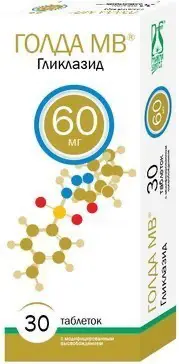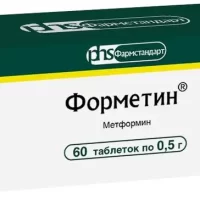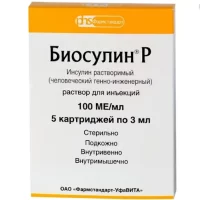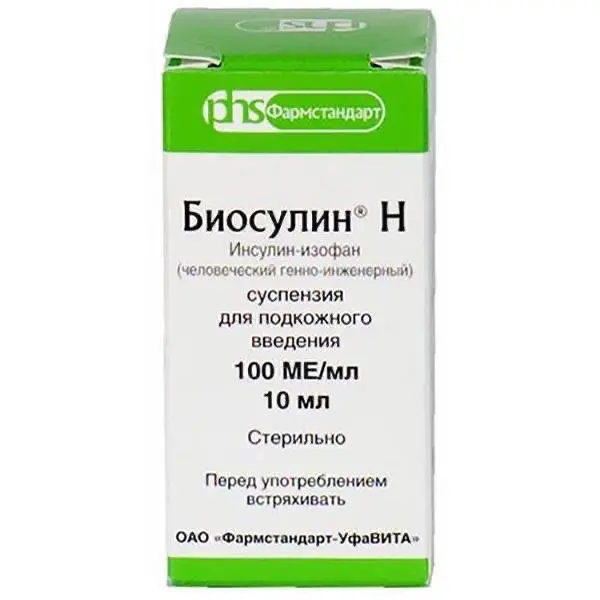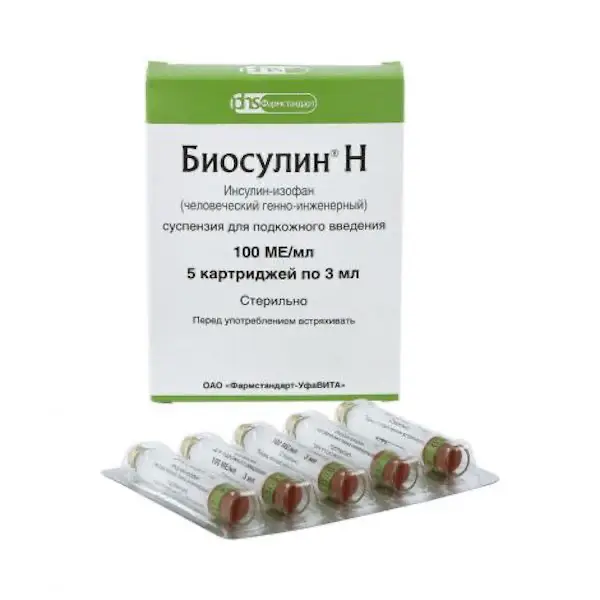Description
Golda MB Pharmacodynamics
Gliclazide is a sulfonylurea derivative, hypoglycemic drug for oral administration, which differs from similar drugs by the presence of N-containing heterocyclic ring with endocyclic bond. Gliclazide reduces blood glucose concentration by stimulating insulin secretion by islets Langerhans cells. Increased concentration of postprandial insulin and C-peptide is maintained after 2 years of therapy.
In addition to its effect on carbohydrate metabolism, gliclazide has hemovascular effects.
Effects on insulin secretion
In type 2 diabetes, the drug restores the early peak of insulin secretion in response to glucose intake and enhances the second phase of insulin secretion. Significant increase of insulin secretion is observed in response to stimulation caused by food intake and glucose administration.
Hemovascular effects
Gliclazid decreases the risk of small vessel thrombosis by acting on the mechanisms which may contribute to the development of complications in diabetes: partial inhibition of platelet aggregation and adhesion and reduction of platelet-activating factors (beta-thromboglobulin, thromboxane B2), restoration of fibrinolytic activity of vascular endothelium and increase of tissue plasminogen activator activity.
Intensive glycemic control based on the use of gliclazide (HbAlc < 6.5%) significantly reduces micro- and macrovascular complications of type 2 diabetes compared with standard glycemic control (ADVANCE study).
The intensive glycemic control strategy involved prescribing gliclazide and increasing its dose against (or instead of) standard therapy before adding another hypoglycemic drug (e.g., metformin, an alpha-glucosidase inhibitor, a thiazolidinedione derivative, or insulin). The average daily dose of gliclazide in patients in the intensive control group was 103 mg, the maximum daily dose was 120 mg.
Against the background of gliclazide use in the intensive glycemic control group (mean duration of follow-up 4.8 years, mean HbAlc level 6.5%) compared with the standard control group (mean HbAlc level 7.3%) a significant 10% reduction in the relative risk of combined incidence of macro- and microvascular complications was shown.
The benefit was achieved by a significant reduction in the relative risk of: major microvascular complications by 14 %, the occurrence and progression of nephropathy by 21 %, the occurrence of microalbuminuria by 9 %, macroalbuminuria by 30 %, and the development of renal complications by 11 %. The benefits of intensive glycemic control against the background of gliclazide were independent of the benefits achieved against a background of hypotensive therapy.
Indications
– Diabetes mellitus type 2 with insufficient effectiveness of diet therapy, physical activity and body weight reduction.
– Prevention of diabetes complications: reduction of risk of microvascular (nephropathy, retinopathy) and macrovascular complications (myocardial infarction, stroke) in patients with type 2 diabetes by intensive glycemic control.
Contraindications
– Hypersensitivity to gliclazide, other sulfonylurea derivatives, sulfonamides or to excipients included in the drug;
– diabetes mellitus type 1;
– diabetic ketoacidosis, diabetic precoma, diabetic coma;
– severe renal or hepatic insufficiency (insulin is recommended in these cases);
– taking miconazole (see section “Interaction with other medicinal agents”);
– pregnancy and breastfeeding (see section “Administration during pregnancy and breastfeeding”);
– under 18 years of age.
Due to the fact that the drug contains lactose, gliclazide is not recommended for patients with congenital lactose intolerance, galactosemia, glucose-galactose malabsorption.
It is not recommended to use in combination with phenylbutazone or danazol (see section “Interaction with other medicinal products”).
Dosage and administration
- THE DRUG IS INTENDED FOR THE TREATMENT OF ADULTS ONLY.
- The recommended dose of gliclazide should be taken orally, once daily, preferably during breakfast.
- The daily dose may range from 30 mg to 120 mg at a time.
It is recommended that the tablet is swallowed whole without chewing or crushing.
If one or more doses of gliclazide are missed, the higher dose should not be taken at the next appointment, the missed dose should be taken the next day.
As with other hypoglycemic drugs, the drug dose in each case should be adjusted individually, depending on the blood glucose concentration and HbAlc index. - Initial dose
The initial recommended dose (including for elderly patients > 65 years of age) of sustained-release gliclazide is 30 mg per day (1 tablet of sustained-release gliclazide 30 mg or ½ tablet of sustained-release gliclazide 60 mg).
If adequately controlled, this dose may be used for maintenance therapy. If glycemic control is inadequate, the daily dose of gliclazide may be sequentially increased to 60 mg, 90 mg, or 120 mg. Increasing the dose is possible not earlier than after 1 month of therapy with the drug in the previously prescribed dose. Exceptions are patients whose blood glucose concentrations have not decreased after 2 weeks of therapy. In such cases, the drug dose may be increased in 2 weeks after the start of therapy.
The maximum recommended daily dose of the drug is 120 mg. - Transition from therapy with gliclazide tablets with immediate release 80 mg to therapy with gliclazide tablets prolonged action
1 tablet of 80 mg immediate-release gliclazide may be replaced by 1 tablet of 30 mg sustained-release gliclazide or ½ tablet of 60 mg sustained-release gliclazide. Careful glycemic control is recommended when converting patients from therapy with gliclazide (immediate-release tablets) 80 mg to therapy with gliclazide. - Transition from therapy with another hypoglycemic drug to therapy with gliclazide
Gliclazide may be used in place of another hypoglycemic oral medication. When transferring to gliclazide, patients receiving other oral hypoglycemic drugs should consider their dose and elimination half-life. As a rule, a transition period is not required. The initial dose of prolonged gliclazide should be 30 mg (1 tablet of prolonged gliclazide 30 mg or ½ tablet of prolonged gliclazide 60 mg), and then should be titrated according to the blood glucose concentration. - When prolonged-acting sulfonylurea derivatives with a long half-life have been replaced with gliclazide, to avoid hypoglycemia caused by the additive effect of the two hypoglycemic agents, their administration may be discontinued for several days. The initial dose of prolonged-acting gliclazide in this case is also 30 mg and, if necessary, can be further increased as described above.
- Combination with another hypoglycemic drug
Gliclazide can be used in combination with biguanides, alpha-glucosidase inhibitors or insulin.
If glycemic control is inadequate, additional insulin therapy should be prescribed with close medical monitoring. - Elderly patients.
No dose adjustment of gliclazide is required for patients over 65 years of age.
Patients with renal insufficiency
The results of clinical studies have shown that no dose adjustment is required in patients with mild to moderate renal impairment. Close medical monitoring is recommended. - Patients at risk of hypoglycemia
In patients belonging to the group of risk of hypoglycemia development (insufficient or unbalanced nutrition, severe or poorly compensated endocrine disorders – pituitary and adrenal insufficiency, hypothyroidism, withdrawal of GCS after their long use and/or administration in high doses, severe cardiovascular diseases – severe coronary heart disease, severe carotid atherosclerosis, widespread atherosclerosis), a minimum dose (30 mg) of prolonged-acting gliclazide is recommended. - Prevention of complications of diabetes mellitus
To achieve intensive glycemic control, the dose of gliclazide can be gradually increased to 120 mg/day in addition to diet and exercise until the target HbAlc level is achieved. The risk of hypoglycemia should be kept in mind. In addition, other hypoglycemic medications such as metformin, an alpha-glucosidase inhibitor, a thiazolidinedione derivative, or insulin may be added to therapy. - Children and adolescents under 18 years of age
There are no data on the efficacy and safety of gliclazide in children and adolescents under 18 years of age.

